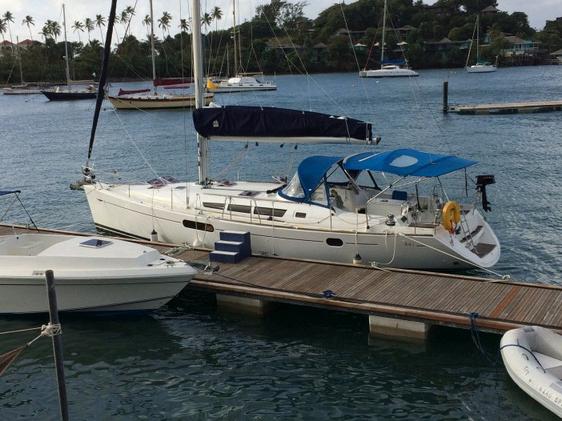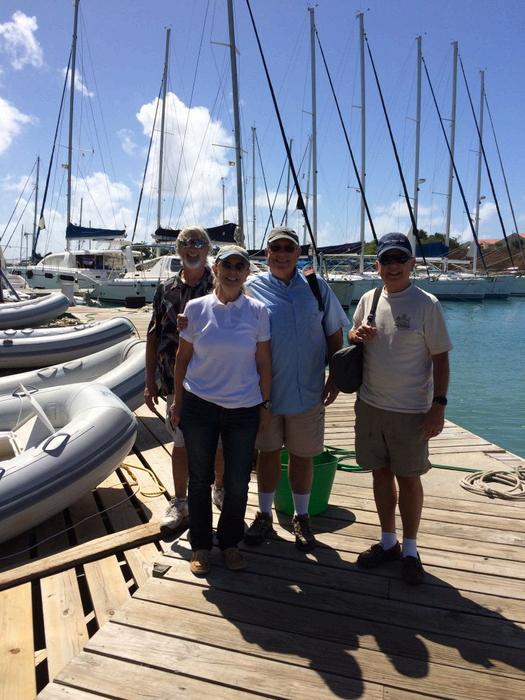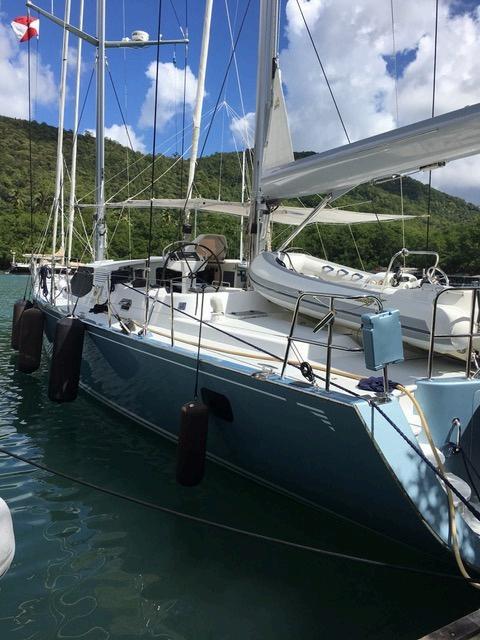
14 minute read
THE JOURNAL OF THE INDIGO, PART II
by theensign
Boater documents two-week sailing charter with friends
BY JIM AMENT
►Jim Ament, the author of this journal, was a crew member on Indigo, a sailing charter boat based in Grenada, Windward Islands. Jim’s journal captures the excitement and adventure of the charter and the importance of the friendships built during that cruise. As for any journal written at sea, the writing style captures the cruise unlike a narrative written after returning home. For this reason, the editors have kept the journal in Jim’s original form and style. We hope that you will enjoy it as much as we do. –Bill Buffum and Laura Landis, Boulder Beacon editors
THIS ARTICLE ORIGINALLY APPEARED IN THE BOULDER VALLEY SAIL & POWER SQUADRON NEWSLETTER, BOULDER BEACON, AND RETAINS THE ORIGINAL EDITORS’ NOTE. READ PART I IN THE FALL 2024 ISSUE OF THE ENSIGN.

The boat
Indigo is a 2009 sloop-rigged 44-foot Jeanneau, with a furling genoa and lazy jacks for the main. It has two steering wheels; a 6-foot 7-inch bulb keel; a fixed threebladed prop; a blade rudder; three staterooms, three heads, a large salon, galley and cockpit comfortable for six people; Raymarine navigation equipment; but no microwave or air conditioning. The charter cost $6,500 for a two-week trip from Horizon Yacht Charters.
The crew
Capt Anne Hammond
Harry Hammond
Bill Buffum
Les Ratekin
Todd Berryman
Jim Ament

The trip
Wednesday, Feb. 1 (Day 8 on the boat, day 6 sailing): Up at 7 a.m., we had oatmeal and coffee for breakfast. Les and Anne went snorkeling before we left the island of Mustique about 9:30 a.m. We passed Canouan, also known as Turtle Island Our destination was Tobago Cays, a national park with spectacular coral reefs and no facilities We hooked to a mooring ball and had lunch: PB&J for me. I did some snorkeling and saw starfish on the seafloor, small fish and a turtle Later, I washed a shirt in a bucket of sea water and then hung it on a lifeline with clothespins indispensable on a cruising boat and supplied by Horizon When it dried, I couldn’t discern any difference by using sea water.
Our captain, Heiden, had told us to find Romeo to provide a great lobster dinner on the beach. We couldn’t find Romeo, but Alfonzo found us and convinced us to go with him. Later, as we were loading into Alfonzo’s boat, a wave pushed his boat against ours where there were no protective fenders, smashing Bill’s hand on the rail. We got Bill back on board and grabbed the first aid kit We concluded that his hand wasn’t broken because he could move his fingers, but it was bleeding, and Bill was on a blood thinner He got that under control, and I put antibiotic ointment on his cut and wrapped it Alfonzo left to cook dinner We waited as the skies grayed; it started to rain intermittently.
Alfonzo showed up with platters and bowls of food covered in aluminum foil. We paid him for the wonderful feast: six whole spiny lobsters, mahi-mahi, salad, plantains, rice with ginger, small half-potatoes with cheese, and a root vegetable We washed the dishes, including Alfonzo’s, who would pick them up in the morning It was windy and rainy, so we closed the hatches, which made for a humid night Everybody went to bed by 9 p.m.
Thursday, Feb. 2 (Day 9 on the boat, day 7 sailing): What a night heavy rains and strong winds all night long! The dinghy banging against the stern, water and fuel tanks sloshing, waves hitting the boat, a banging halyard. The noises from below meant that we mostly napped rather than getting a good night’s sleep. A lazy morning ensued, with continuing wind but clearing skies. We had pancakes, eggs and coffee for breakfast.
We discussed what to do next: Sail to our next location or wait until the wind subsided, hoping the snorkeling would be better as it was probably cloudy from the weather We’d had sustained winds of 20 knots, with gusts much greater, but few big waves inside the protection of the reefs It was choppy, though Force 4–6 weather per the Beaufort wind scale. We left Tobago Cays at 11:30 a.m., motoring a short distance to Mayreau, the smallest inhabited island of the Grenadines with about 250 residents. We moored at Saline Bay. Later, Anne took Les, Bill, Todd and me in the dinghy and beached it so we could check out the area. Locals were selling shirts and dresses, and a party was set up to entertain the passengers of Windstar, a large motorsailer tour boat. When Anne came to pick us up, we convinced her to tie up the boat and join us for a beer.
Back on the boat, I cooled off in the ocean and then rinsed myself with freshwater from the hose at the stern. After, I took a short nap on the foredeck. We had snacks before dinner cheese, crackers and nuts. Dinner was an excellent rice bowl concoction with sausage and a salad that Todd made. He’s a good cook!
Friday, Feb. 3 (Day 10 on the boat, day 8 sailing): We headed to Union Island to clear customs from St. Vincent and the Grenadines. Three thousand inhabitants live on this 3-mile-long island visible from Mayreau. After breakfast, we left. We saw beggars and people selling ice, bread and fish Goats combed through the trash, looking for something to eat, and dogs wandered around lazily. The buildings were in disrepair.
Back at the boat, we had macaroni and cheese for lunch and then left for Tyrell Bay on Carriacou Island at 1 pm to check into Grenada. This was relaxed downwind sailing at 5 knots or more for about 2½ hours. We anchored there for the night and then Anne and I took the dinghy to shore to deal with the paperwork. While waiting on Rick to take care of his fees, we met a tanned Dane with wild blond hair, a beard and powder-blue eyes who was sitting in line. He and four friends had built a 40-foot, thick-hulled wooden boat, named itilia, in 2015 to a 1910 design by naval architect Colin Archer. It had no winches but used old-style pulleys and lines for the sail systems. Anchored in the bay, the boat was beautiful with a wooden mast. They had sailed it from Denmark.
We had trouble finding our boat. This went on for about 10 to 15 minutes—four lost souls floundering around in undisciplined patterns.
When Anne got to the immigration officer, we had a minor paperwork problem and he was ready to close, so we had to come back in the morning. We had snacks on the boat, talked about the day, and then Bill, Les, Todd and I had a swordfish dinner at The Original Slipway, a rickety old restaurant on shore decorated with old boatbuilding machinery and boats hanging from the ceiling. Our seats looked like old ferry boat benches, but the place was busy and the food was good. When we left in the dinghy, there must have been 30 to 40 boats out there with their anchor lights on, all looking identical in the dark. Needless to say, we had trouble finding our boat. This went on for about 10 to 15 minutes four lost souls floundering around in undisciplined patterns unable to find boats that we knew were near us. Harry and Anne could hear us and shined a light to where they reasoned we were We didn’t catch on until they jiggled it, and we headed straight for it, saved from running around all night. Did we have phones with us? No, but we talked about other practical solutions, such as a unique light easily differentiated from all the standard anchor lights, to be used only in such circumstances. We had lots of laughs and then went to bed. I think this was the night that Les, a big guy, threatened to join us in the stateroom. What he really wanted, thank goodness, was to switch sleeping places I readily agreed!
Saturday, Feb. 4 (Day 11 on the boat, day 9 sailing): After coffee, Anne, Les and I went to shore to take care of immigration. We met an older couple from British Columbia on their 39-foot sailboat on the hard. They had sanded their hull and painted it themselves with copper-based marine paint, which is illegal in many parts of the world due to toxic effects on marine life. It also works better than other antifouling coatings. They had been in South Africa and up the US East Coast. They visited New York City; Charleston, South Carolina; and points south. They came to Tyrell Bay because of the good boatyard, which had an expensive new crane. They never said where they were headed next. The man said it was his wife who decides where they go; she was the one who wanted to take off sailing around the world, and he just went where she did.

We left them and saw more of the area by Slipway in the daylight—a cactus growing on a rooftop and old machinery like a large, rusted engine that pulled boats up from the water. Back on the boat, we had oatmeal and orange juice for breakfast, and then pulled the anchor and left for Grenada at 10 a.m. It was great sailing, mostly 6 to 9 knots with a reefed main and full jib up.
We arrived at Happy Hill Bay north of St. George’s and hooked to a mooring ball for the night. Anchoring was prohibited because of the protected reef, but a catamaran pulled in and dropped anchor nearby. We yelled to them that it was not allowed. They thanked us, quickly retrieved it and hooked to a mooring ball. I swam while others went snorkeling Later, Anne and Todd prepared an apple and lettuce salad and a tuna, rice, pepper, onion and bean main dish. Interesting discussions ensued, but everyone started thinking about bed at 7:30 pm.
Sunday, Feb. 5 (Day 12 on the boat, day 10 sailing): I got up early and went out on the back deck, stretching a little while others got up. We had scrambled eggs, fruit and the rest of the oatmeal for breakfast. We then left our mooring and motored a short distance to a spot where Les, Anne and Todd snorkeled. Bill, Harry and I stayed on the boat and talked.
When the snorkelers got back, we had a nice two-hour sail back to the Horizon Charter dock. Our sail was sadly coming to an end
Harry, Anne, Bill and I stayed on the boat and ate leftovers for lunch while Todd and Les went to a restaurant on shore, starving for cheeseburgers. Some of us then went to a saltwater pool to cool off and relax. Afterward, I took a shower and shaved, which felt good. In the late afternoon, I had a Carib beer at the Dodgy Dock with Bill, Todd and Les, and John from the catamaran joined us. He and Bill grew up together in Michigan and learned how to sail together in their youth.
At 6 p.m., some of us walked to the restaurant Bananas, which was showing the Super Bowl on a large screen. The service was awful! Clearly untrained, the poor waitress had probably been summoned by a relative to help on what was expected to be a busy night They only had one menu, which we had to read using our cell phone flashlights. Rick and his crew had joined us, but they couldn’t handle the inefficiency and left. We fought through it and laughed when the waitress requested we give our one menu to another table that had just arrived. The food was fine but not memorable, and paying the bill was a bit of a circus, but we left at halftime in good spirits. We were in bed by 10:20 p.m., assuming the Atlanta Falcons would win.
Checkout with Horizon was simple, mainly because we returned the boat as we had received it.
Monday, Feb. 6: After a good night’s sleep in the salon, I helped with breakfast and organized my stuff. We were shocked to learn that the Patriots beat the Falcons in overtime. Checkout with Horizon was simple, mainly because we returned the boat as we had received it. We loaded our luggage into a large taxi van and took a tour of the island, which we had already booked.
Our guide, Keith, showed us sites of early slave trading in St. George’s and explained that the forests were replaced by sugar cane and cotton plantations owned mostly by Scottish and English landholders. The volcanic soil is fertile, and the land is full of varied plant life. Keith said one could grow all the fruits and vegetables necessary to sustain a family, with some left over to sell, with about an 11,000-square-foot plot of land and a 4,000-square-foot house on it.
We toured a nutmeg factory, an important crop in Grenada (the spice island), and a chocolate factory. We went into the rainforest, visited a beautiful waterfall and watched monkeys at about 1,900 feet elevation. Keith told us of the devastation of Hurricane Ivan in 2004, which wiped out 90% of the crops. The St. George’s University medical school is a bright spot for the island. There are about 35,000 cars on the island, mostly Japanese-made. I only saw one person on a bicycle, but it’s understandable. The roads are very steep, curvy and not well maintained.

When the tour was over, we checked into the La Heliconia Hotel, the same place we stayed at the beginning of the trip. I had a beer with Todd and got my stuff organized on the fold-out bed. Todd, Les and I shared a room. We went to dinner at a place the hotel recommended. It turned out to be a fancy bowling alley and pool hall with a restaurant upstairs overlooking the alleys. It had to be one of the noisiest places I’ve ever been in. The service was slow, but the hamburger and Carib beer were good. The hotel van picked us up at 8:30 p.m., and I was in bed by 9:30 p.m. after a shave and a shower. I noticed that the bed didn’t roll, and there were no strange boat noises during the night. I slept well and was up at 5:30 a.m. for a 6:15 a.m. taxi to the airport.
Tuesday, Feb. 7: We checked in as soon as we got to the airport The flight was late to depart, but the plane wasn’t full, and we had room to stretch out I enjoyed the speedy immigration check in Miami, a result of having a Global Entry pass. My wife, Karen, picked up Les and me, and we drove him home I was tired but pleased by my experience.

Final thoughts
The sailing was wonderful, thrilling at times; I couldn’t have asked for better, and I learned a lot. The crew was terrific. Engaging people with interesting backgrounds, everyone pitched in. It was good to get to know them, and I’d join them again anytime, if they’d have me!
The boat was fine. Yes, we had an engine problem part of the adventure and the water and fuel gauges constantly read full, but all in all, the boat worked for us. I only saw two insects—flies. I assume there were creepy crawlers somewhere, but I didn’t see any, and I saw no mosquitoes, I assume because of the trade winds. A couple of people mentioned that they’d been bitten in the night by no-see-ums.
There is a lot of poverty in the Caribbean islands, but the people were pleasant. Tourism is important to the economy, and it was interesting that there appeared to be a competition between those from St. Vincent and Grenada.
I would do this trip again in a heartbeat as I absolutely loved it. A big thanks to Les for getting me involved! ■
ABOUT THE AUTHOR
Jim Ament was born in 1942 and raised in a small Ohio town He attended a small Ohio college and joined the Ohio National Guard and then got a job with a worldwide aluminum company He married his wonderful wife in 1970, and their marriage is still going strong. They moved a lot due to promotions and traveled the world on business and pleasure. In 2005, Jim retired to the beautiful Colorado Rockies.










